I receive a lot of emails about paper piecing each week. While many of them are in reference to my Harry Potter patterns, even more of the messages are from new and experienced quilters alike, with comments about the technique itself. Most commonly, I hear one of two things. Either that the person emailing had never quilted and saw a pattern they really wanted to try and just went for it, then was surprised that it wasn’t as hard as they thought OR that they have wanted to try it for years and it looks too hard to them.
I’m always thrilled to hear from quilters of all skill levels, and any time I can help in whatever small way, it’s my great pleasure to do so.
Paper piecing can be daunting to someone that either hasn’t tried it before or tried a technique that confused them. I myself tried three separate tutorials before it stuck. It was a combination of those different tutorials that helped me understand it better, and while I do have my own How To now, I still recommend checking out several tutorials and deciding on what techniques are right for yourself.
That said, this is how I paper piece. Each pattern is the same. They all have the same basic set up and the same basic rules will always apply. Even thought designers sometimes draw their patterns differently, the technique remains the same.
How To Paper Piece
© Jennifer Ofenstein
click on tutorial images to see larger versions

Supplies
- pattern (Jar #3 used in this tutorial or similar pattern – NOTE: Jar #3 was updated in 2014 and looks a little different than the photos, but the lines are all in the same place)
- quilting fabric
- neutral thread
- paper scissors
- fabric scissor OR Add-A-Quarter Ruler.
- postcard or thin straight edge
- flathead pins
- rotary cutter*
- rotary ruler
- wallpaper seam roller (available at home improvement stores)
*note – I keep two rotary cutters, one for traditional piecing and one for trimming paper pieced blocks. The “just fabric” cutter gets the new blade, and when it begins to dull, I transfer it to the “paper” rotary cutter.
Not shown above:
- cutting mat
- dry iron
- sewing machine
- open toe foot
- light source
Start by making a copy or print out of the pattern you want to make. Use lightweight paper for your patterns, as it tears off easier. Recycled printer paper works well, as does tracing paper and some drawing papers. There are also a number of commercially available products just for paper piecing, such as Carol Doak’s Foundation Piecing Paper.
Choose fabrics you think will compliment the pattern. Always use good quality 100% cotton quilting fabric.

Use paper scissors to trim outside the gray seam allowance of individual pieces of the pattern.

Starting with pattern piece “A,” use the postcard as a straight edge, fold the pattern piece on the line between 1 and 2. This is your stitching line.

Repeat for the line between 1 and 3.

Place fabric 1 right side up on the back of the paper opposite piece 1.
Make sure you have a generous seam allowance (approximately 1/2″) all around.
Use a light source behind the pattern if you need it to make sure the fabric is big enough.
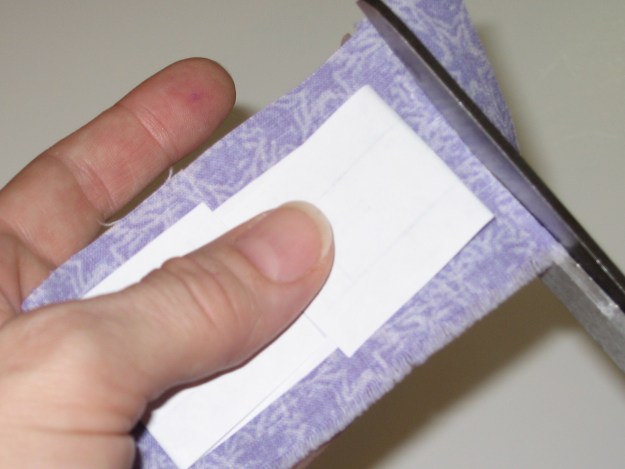
Trim seam allowance to 1/4″. This can be done with fabric scissors or a rotary cutter.

Place fabric 2 wrong side up on fabric 1. Make sure to slide both pieces of fabric 1/4” past the stitching line.

Using a small stitch (10-12 stitches per inch, a 1.5 on most domestic sewing machines), start two stitches before the stitching line, stitch along the line and take two stitches after the end. By stitching slightly pass the line, it is less likely that the ends the stitches will pull out when the paper is removed.

Trim thread to paper.

Fold fabric two out. Gently dry press with an iron OR use the wallpaper seam roller (shown) to press out the seam. Be careful not to pull or tug on the fabric.

Fold on the 1 > 3 line. Keep the paper folded then flip the pattern over. Trim a generous 1/4″ from piece 1 either with scissors or with your Add-A-Quarter Ruler.
Unfold the paper. Place fabric 3 wrong side up on fabric 1, matching the edges, which will be 1/4″ past the stitching line after being trimmed in the previous step.
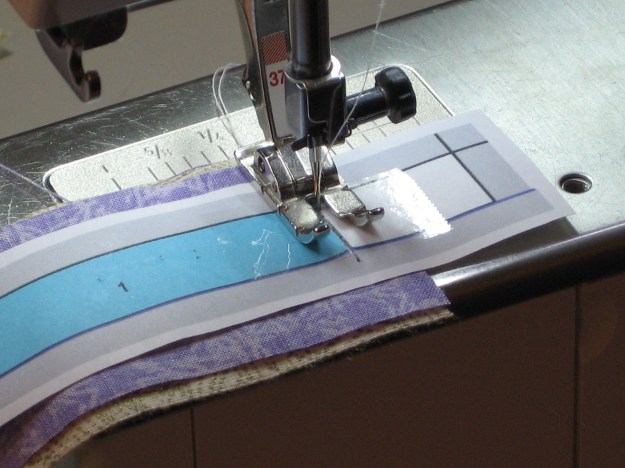
Repeat stitching as for line 1 > 2.

Press as before.
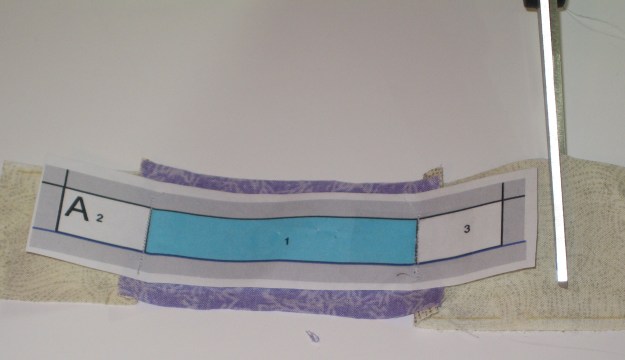
Trim fabric around pattern piece, leaving a generous amount for squaring up later.
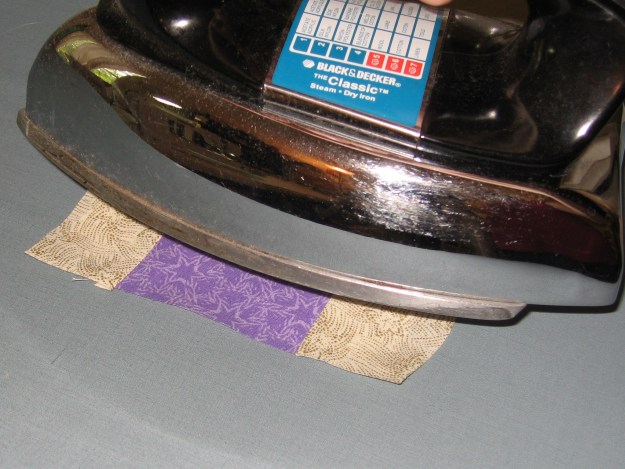
Press pattern piece “A” with a gentle up and down motion using a dry iron. Do not pull or tug the fabric.
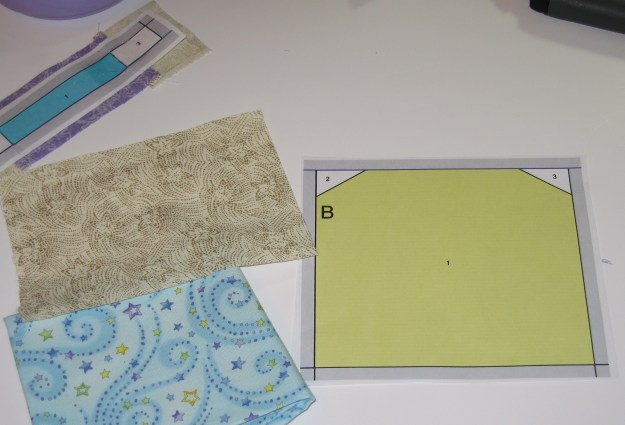
Now for pattern piece “B.”

Using the postcard or straight edge, fold down the lines between section 1 > 2 and 1 > 3.
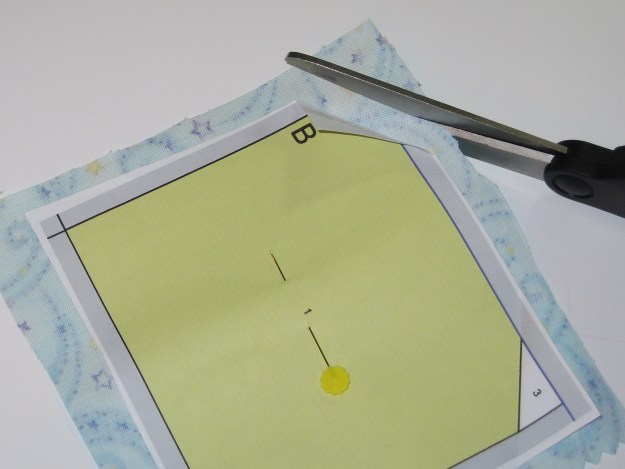
Trim a generous 1/4″ seam allowance (with scissors or Add-A-Quarter ruler) for piece 1 >2. Repeat for 1 > 3.

Just as for pattern piece “A,” place fabric 1 right side up on the back of the paper opposite piece 1. Make sure you have a generous seam allowance (approximately 1/2″) all around.

Stitch on the line between piece 1 > 2 as in previous steps.
Repeat for pieces 1 > 3.
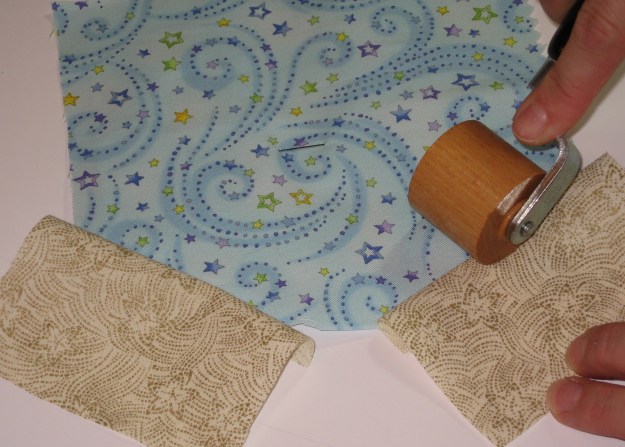
Press seams as before.
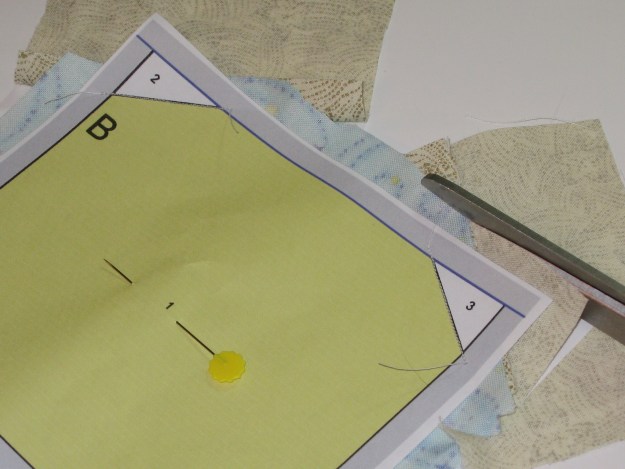
Trim fabric, leaving a generous seam allowance around the outside edges for squaring up later.

Press as before.

This is what you should have so far.

On your cutting mat and with your ruler, find the inside line at the top of unit “B”, where the jar will be stitched to the lid.
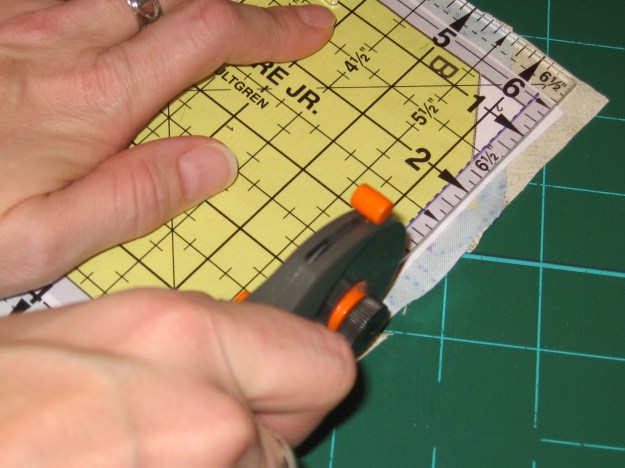
Using the pattern’s seam allowance as a guide, trim. (note: Not all paper pieced patterns include seam allowance. All of my patterns do, but if you’re ever working on a pattern without seam allowance, you can add it using this simple tutorial.)

Find the corresponding seam on unit “A” and repeat the process.
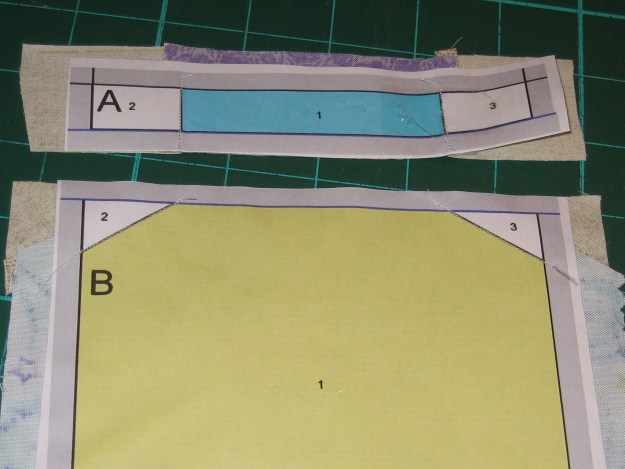
Now the “A” pattern piece is ready to join to the “B” pattern piece.

Use a pin to find the outside corner. Push the pin through this point.

Find the corresponding point on the other pattern piece. Push the pin through.

Push the pin all the way through to line up the pattern pieces. This will assure that your pattern pieces align correctly when stitching.

Using the pin keep the pattern aligned, stitch along the seam line.
Tip: Use Wonder Clips to hold the seam in place. (Not shown…Wonder Clips are awesome, but they came out after I originally wrote this tutorial!)

This is what you have now.

Remove the paper seam allowance that was just stitched on the “A” piece.

Repeat for the “B” piece.

Open the block and press. The seam can be pressed to one side or pressed open. I usually let the fabric decide for me.
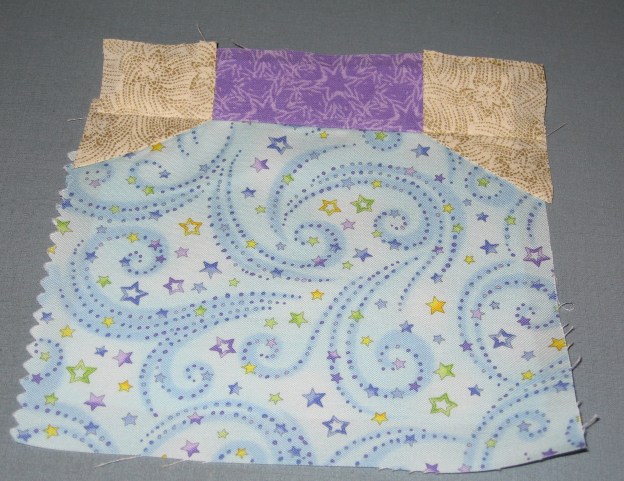
Now you have this from the front.
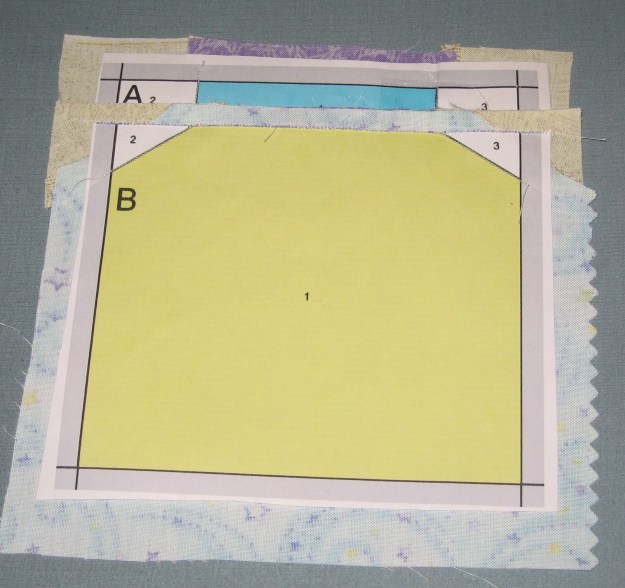
And you have this from the back.

Time to square up the block! Align the ruler with the bottom edge with the seam allowance inside. Trim to 1/4″.

Using the first cut, square up the block to 5 1/2″. If the pattern is a little off, go with the ruler’s measurement and not the seam allowance on the pattern. Printers vary widely, as do patterns. You can make minor corrections by squaring up the block.
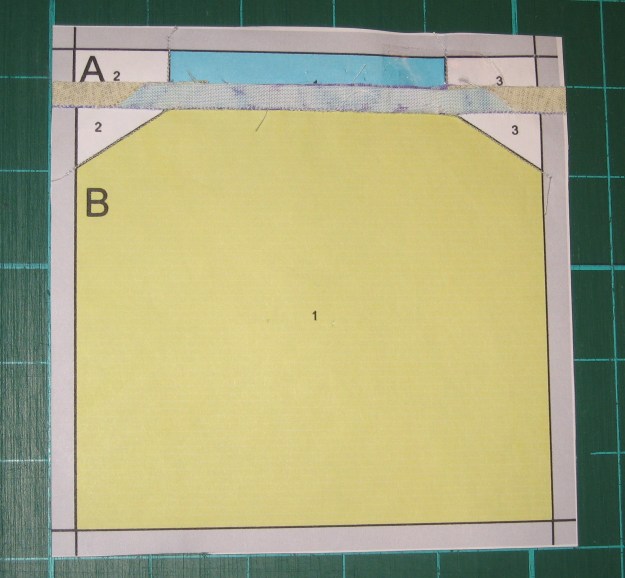
Now you have this…all squared up! Leave the paper attached until the block is in it’s final location. That will keep the bias seams from stretching.
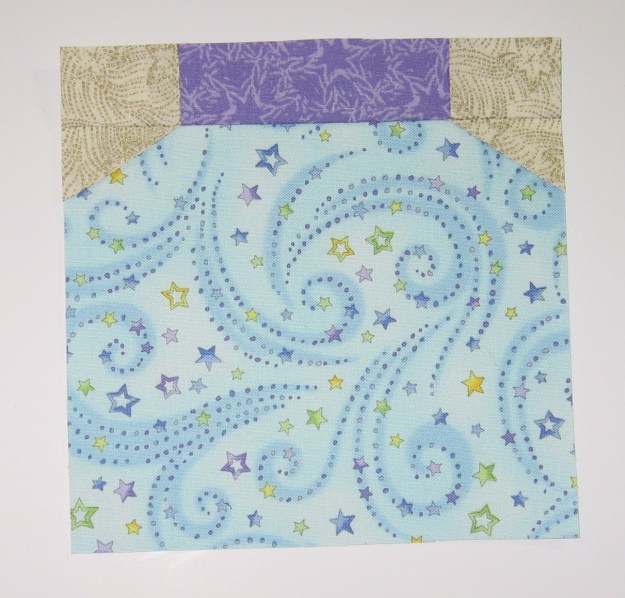
From the front!
Use this block for quilts, pillows, bags, pot holders, wall hangings or anywhere else you’d use a square of fabric or a quilt block!
You can find lots of free patterns right here on Sewhooked!
Join the Sewhooked Facebook Group for community, support, & prizes!

Posts on this blog may contain affiliate links but I have no control over “sponsored posts” which are the price I pay for a less expensive website. Thank you for your understanding & support. ♥


I have copied the harry potter paper peiced patterns but when i went to put them together they are backwards and dont look like yours the directions of some points as in the capital H point down instead of up. i can turn it around but then the right side is on the left and visa versa. as you can see im new at all this. thanks for any help deb also love your videos etc on you tube look forward to them and they got me sewing again.
Paper pieced patterns do come out mirror-imaged after they’re made and should look like the sample finished block. It might help to compare the pattern side by side with one of the finished blocks so you can visualize it.
For example, you can look at the image of the “H” and then the pattern of the “H”.
It can seem a little bit crazy when you first start working on them! Let me know if that helps!
Jennifer
I am really discouraged on this – I am an experienced sewer – but this has me bumfuzzled. When copying the pattern do you need to enlarge it, or are the pieced already sized?
Most paper pieced patterns will be actual size (all of mine are) when you print. You can always enlarge or decrease as you like.
I hope you don’t get too discouraged…let me know if you need any pointers!
I am eager to begin this project with my granddaughter, a true Harry Potter fan.
How wonderful! I hope you and your granddaughter both enjoy the experience!
I have noticed that most patterns separate out the different sections (A, B, C, and soforth), but in a pattern like the gnomelette, they all come as one pattern with the sections separated by doted lines. Do you need to print multiple pages to do this or can you cut on the lines between the sections? It is hard to explain; I hope that makes some sense.
I get just what you mean. You can cut right on the dotted line. You still need to add 1/4″ seam allowance. You can do that yourself, or, if you’re like me and really like for your patterns to have seam allowance, you can add it before piecing. I have an easy way to do that here.
Thank you so much for your quick feedback! This is my very first paper piecing project, and I just happened to pick one that wasn’t laid out step by step for me. 🙂 Usually if I don’t have a pattern with a seam allowance built in, I completely forget, but I was careful to remember and it turned out great. Well, passable for most, but great for me! 😀
Hi love the site and will definitely using it to make my next quilt. I have made a few appliqué style quilts this year of Doctor Who and have had several requests for patterns. Seeing yours, do you have any tips on how to approach making one of an appliqué. Oh, you can see the quilt I made here. I’m not a master quilter, but I thought I would share my Doctor Who quilt creation I recently finished with you being that I love your work so much. I hope you like it as much as i do. https://www.etsy.com/listing/103952672/doctor-who-applique-patchwork-quilt. I’d love your feedback.
I’m sorry, I’m really trying to understand paper piecing, but it seems as if you waste a lot of material. Is this true or just my perception in how I’m reading this?
Thank you for sharing this! I am very excited that I found your site. I hope you don’t mind, but I shared this and you free pattern page with my quilting group on Facebook.
Oh, I don’t mind at all! The more paper piecers out there…the better!
I have just completed my first paper piecing. I found if I draw the lines on the back of the print out using a light box or window, and use these as a fabric guide and only sew on the printed lines that the block come out the right way.
How do you get the paper pieces for all the Harry Potter ones every time I click on the one I like I just takes me to flicker
Hi Tori, you need to click on the pattern name. That’ll take you directly to the pattern itself instead of the photo.
Happy stitching!
Your tutorial with the heart of how to make a paper piecing pattern makes it look so easy. I made the Blues Clues Quilt and you have some of my squares up on Fandom In Stitches. (Shovel and Pail and Pepper) I am trying to make a Spirit the horse pattern and failing so far (from Net Flix) Spirit Running Free. I’m trying to model somewhat after the Chase pattern from Paw Patrol but still when I try it out I’m ending up with raw edges (don’t even know how fully describe—seem ripper marathon). But I’m stuck with where to divide into big pieces vs continue on same piece.
Jane, are you in the Fandom in Stitches Designer & Pattern Tester group on Facebook? There are a lot of helpful people there, and many, many of our Fandom designers, who are always willing to help, myself included. Definitely consider joining so we can give you a hand! https://www.facebook.com/groups/fistesters/
Thank you, Thank you, Thank you!! Loved your video.